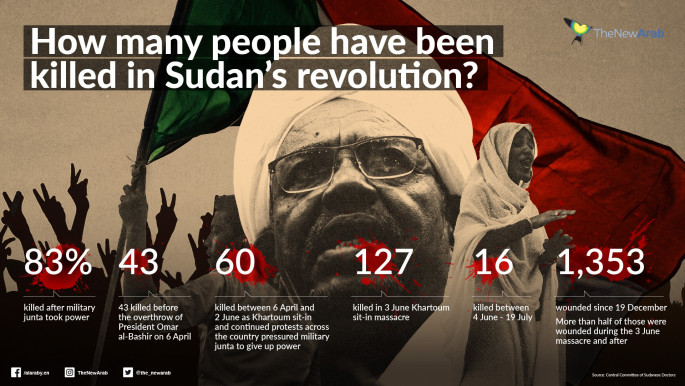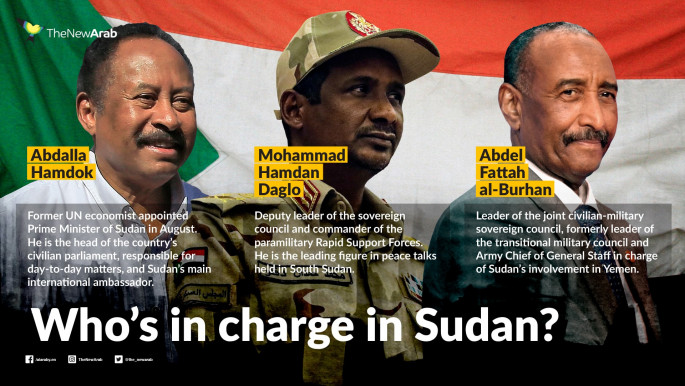Sudan's security forces must be held to account over 'ruthless' crackdown, Amnesty says
Previous reports have pinned attacks on demonstrators solely on the National Intelligence and Security Services (NISS) during former dictator Omar Al-Bashir's reign and on the paramilitary Rapid Support Forces (RSF) after his ousting in April last year.
The new Amnesty investigation released on Wednesday documents how other elements of the security apparatus, including the police, were involved in attacks on demonstrators.
A deadly June crackdown that killed at least 100 people and was previously reported to have been led by the paramilitaries also involved NISS and police officers, Amnesty has now revealed.'Ruthless' crackdown begins in Atbara
The report shows how the NISS' armed operation unit in the city of Atbara led the first deadly crackdown on protesters in December 2018, when the revolt against Bashir began.
Initial protests against Bashir, who seized power in a 1989 military coup, were sparked by skyrocketing bread prices linked to a cut in government subsidies.
The first attack on protesters in Atbara, where the demonstrations began, killed three people - engineering student Tariq Ahmed, 27-year-old labourer Ali Hussein and Mariam Ahmed Abdalla.
 |
| [Click to enlarge] |
Ahmed and Hussein were respectively shot in the chest and the head, dying an hour later in hospital. Abdalla was shot dead in her home.
"During our research many victims and their families clearly pinpointed specific arms of the security forces that ruthlessly attacked protesters," said Deprose Muchena, Amnesty International's Director for East and Southern Africa.
"Tariq and all other people who were killed by NISS officers were only exercising their rights to freedom of assembly and their families must get justice."
The human rights organisation has documented 77 deaths from mid-December 2018 until 11 April last year, when the Sudanese military ousted Bashir. The government said just 33 people were killed.
Conflicting data on fatalities
Those conflicting figures reflect a wider pattern of uncertainty around how many people were killed in demonstrations against Bashir and the transitional military council that took power in April.
The paramilitary RSF - an officialised offshoot of the Janjaweed militias accused of war crimes and genocide in the Darfur conflict - is alleged to have led the subsequent attacks on demonstrators after 11 April.
[Article continues after interactive timeline below]
On 3 June, RSF troops led a brutal raid on a Khartoum protest camp, killing at least 100 people. The paramilitary forces' involvement in the attack has been verified by eyewitnesses and human rights organisations including Amnesty and Human Rights Watch.
Survivors of the bloody massacre also identified NISS agents and police officers as perpetrators, Amnesty said on Wednesday.
An exact death toll for the raid - during which doctors and protesters were beaten, raped and shot - is uncertain.
Amnesty estimates that at least 100 people were killed and more than 700 others injured based on data gathered from credible sources, including an organisation of families of the victims.
Read more: One year after Bashir's downfall, Sudan's revolutionaries sleep with one eye open
The Central Committee of Sudanese Doctors (CCSD) has said that at least 127 people were killed on 3 June, whereas the US-based NGO Physicians for Human Rights said late last month that as many as 241 people were killed.
Even official figures do not match up, with Sudan's National Human Rights Commission reporting just 36 killed, the ministry of health saying 46 were killed, and the attorney-general stating that 87 protesters were killed that day.
"We were flabbergasted to discover that not one government agency could precisely and authoritatively say how many people were killed in the protester crackdowns," Muchena said.
"The Sudanese authorities must spare no effort to properly document and verify the true extent of atrocities committed, including by among other things, involving the affected families," he added.
Furthermore, another 20 people are still missing after the 3 June raid, according to Fadia Khalaf, founder of the Initiative for Missing People. That figure is higher than that of five stated by the Sudanese Professionals Association (SPA) late last year.
Call for comprehensive justice
Amnesty has urged the Sudanese authorities to provide for comprehensive justice for demonstrators killed in 2018 and 2019.
"All those found responsible, including through command responsibility, must be brought to justice through fair trials, but without resorting to the death penalty," Muchena said.
In December, 27 NISS agents found guilty of the torture and subsequent killing of a protester were sentenced to death.
 |
| [Click to enlarge] |
Mohammed Hamdan Daglo, commander of the RSF, is a high-ranking member of the ruling sovereign council, for example.
"We are urging Sudan's transitional authorities to hold thorough, effective and independent investigations into all protester killings and other human rights violations. The investigations must cover all phases of the protests, particularly from mid-December 2018 to 2 June 2019," Muchena said.
"Every victim must get justice."
Follow us on Facebook, Twitter and Instagram to stay connected



